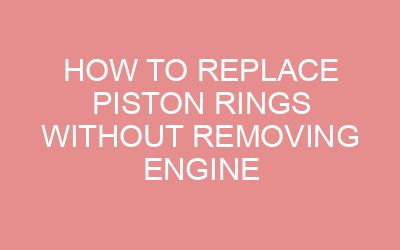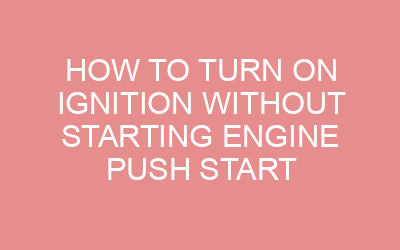To remove the dipstick tube from the engine block, locate the securing bolt and use a socket wrench to loosen it. Once the bolt is removed, carefully wiggle and pull the dipstick tube out of the engine block.
When maintaining or repairing an engine, it’s essential to have a clear understanding of how to perform specific tasks. One such crucial skill is the proper removal of the dipstick tube from the engine block.
Whether for routine maintenance, repair, or replacement, knowing the correct procedure is vital for ensuring the overall health and performance of the engine.
We will explore the necessary steps and precautions to effectively remove the dipstick tube from the engine block, allowing you to carry out the required work efficiently and safely.
Understanding The Dipstick Tube And Its Purpose
Definition And Function Of Dipstick Tube
The dipstick tube is a cylindrical, metal or plastic piece that holds the dipstick in place, allowing it to access the engine oil for accurate measurement.
It is typically secured into the engine block and extends to the oil pan, providing a sealed path for the dipstick to reach the oil reservoir.
Significance Of Proper Removal
It is crucial to understand the proper removal of the dipstick tube from the engine block as it directly impacts the accessibility for maintenance and servicing of the engine. Improper removal can result in damage, leaks, or difficulty in accessing vital components within the engine block.
Preparing For Removal
Before you can remove the dipstick tube from the engine block, it’s important to properly prepare for the task to ensure a smooth and safe removal process.
This involves gathering necessary tools, taking precautions, and ensuring safety measures are in place. Let’s dive into the essential steps for preparing to remove the dipstick tube.
Gathering Necessary Tools
Before beginning the removal process, it’s crucial to gather the required tools to ensure a seamless procedure. Here are the essential tools you’ll need:
- Socket Wrench Set: To loosen and remove any bolts securing the dipstick tube to the engine block.
- Pliers: For gripping and maneuvering the dipstick tube during the removal process.
- Safety Gloves: To protect your hands from sharp edges and potential oil exposure.
- Safety Goggles: To shield your eyes from any debris or oil splashes.
- Rubber Mallet: Useful for gently tapping the dipstick tube if it’s stuck in place.
- Penetrating Oil: For lubricating the dipstick tube and loosening any stubborn connections.
Precautions And Safety Measures Before Removal
Prior to initiating the removal process, it’s vital to take specific precautions and implement safety measures to prevent any potential mishaps. Here are the key precautions and safety measures to consider:
- Ensure the Engine is Cooled: To avoid any risk of burns, allow the engine to cool down completely before attempting to remove the dipstick tube.
- Identify and Disconnect any Electrical Connections: If the dipstick tube is near any electrical components, ensure that power sources are disconnected to prevent electrical hazards.
- Support the Vehicle: If necessary, safely elevate and secure the vehicle to create ample working space and ensure stability during the removal process.
- Use Proper Lifting Techniques: When reaching under the vehicle or lifting heavy components, practice proper lifting techniques to avoid strains or injuries.
- Keep the Work Area Clean: Clear any debris and ensure a clean work environment to minimize the risk of accidents and ensure better visibility.
Step-by-step Process Of Removing The Dipstick Tube
If you need to remove the dipstick tube from the engine block for maintenance or repair purposes, you’ll want to follow a step-by-step process to ensure a smooth and safe removal.
Properly detaching the dipstick tube requires attention to detail and careful handling to prevent damage to the engine block or the tube itself.
In this guide, we will walk you through the necessary steps to remove the dipstick tube from the engine block, ensuring a hassle-free process.
Draining Oil If Necessary
Before attempting to remove the dipstick tube from the engine block, it’s essential to drain the oil from the engine.
This prevents any spills and makes the removal process cleaner and safer. Make sure to have an appropriate container to collect the used oil.
Detaching The Dipstick Tube From The Engine Block
- Start by locating the dipstick tube on the engine block.
- Use the appropriate tools to detach any securing bolts or clamps holding the tube in place.
- Gently wiggle and pull the dipstick tube from the engine block, ensuring not to use excessive force to avoid damaging the tube or the engine block.
- Inspect the tube and the surrounding area for any signs of damage or debris.
Handling And Storing The Tube Properly After Removal
After successfully removing the dipstick tube, it’s crucial to handle and store it carefully to prevent any damage. Clean the tube thoroughly to remove any residual oil or debris.
Store the tube in a safe and clean environment, away from potential sources of damage or contamination.
Troubleshooting And Common Challenges
Removing the dipstick tube from the engine block can sometimes pose challenges, especially if it has been in place for a long time. It’s essential to troubleshoot and be aware of potential obstacles before attempting to remove the tube.
Potential Obstacles During Removal
- Corrosion and rust buildup around the tube
- Tight or seized fit due to prolonged exposure to heat and engine vibrations
- Accumulated debris or dirt causing resistance during removal
Tips For Safely Overcoming Challenges
- Apply a penetrating lubricant: Prior to removal, liberally apply a suitable penetrating oil around the base of the dipstick tube. Let it sit for a few hours to help loosen any rust or corrosion.
- Use heat: Gently heat the area around the tube with a heat gun or torch to expand the metal and aid in loosening the tube.
- Employ a puller tool: If the tube is stubborn, a puller tool can provide leverage and help in extracting it without damaging the surrounding components.
- Carefully tap with a mallet: Use a rubber mallet to lightly tap the sides of the tube to help break up any corrosion and ease its removal.
Conclusion And Final Checks
After successfully removing the dipstick tube from the engine block, it’s important to complete the final checks to ensure the process was completed correctly.
There are two critical aspects to focus on during this stage: Ensuring Proper Sealing and Reinstallation and Confirming Successful Removal and Reinstallation.
Ensuring Proper Sealing And Reinstallation
When reinstalling the dipstick tube, it is crucial to ensure proper sealing to prevent any oil leaks. Before reinserting the tube, make sure the O-ring is in good condition and properly lubricated with clean engine oil.
Carefully guide the tube back into position, applying gentle pressure to seat it securely into place. Ensure that it is tight and flush with the engine block, but avoid over-tightening to prevent damage.
Confirming Successful Removal And Reinstallation
Once the dipstick tube is reinstalled, it’s important to confirm successful removal and reinstallation. Double-check the seating of the tube and any connections to the engine block.
Start the engine and let it run for a few minutes, then shut it off and check for any oil leaks around the dipstick tube. If no leaks are present, then the removal and reinstallation were successful.
Frequently Asked Questions On How To Remove Dipstick Tube From Engine Block
How Do You Get A Dipstick Tube Out Of A Block?
Carefully pull the dipstick tube from the engine block using pliers or a specialized tool. Ensure to work gently to avoid damaging the block or tube. Apply penetrating oil if the tube is stuck. Twist and pull the tube until it comes loose.
Clean the area after removal.
Can You Remove the Dipstick Tube?
Yes, you can remove the dipstick tube. Ensure proper care to avoid damage.
How Do You Remove A Stuck Dipstick?
To remove a stuck dipstick, apply penetrating oil and let it sit for a few minutes. Gently wiggle and twist the dipstick while pulling it out. Avoid using excessive force to prevent damage. If it remains stuck, seek professional assistance from a mechanic.
Can I Drive Without a Dipstick Tube?
It is not recommended to drive without a dipstick tube as it can lead to oil leaks and engine damage. The dipstick tube helps maintain proper oil levels and prevents potential issues. It’s best to address any dipstick tube problems before driving your vehicle.
Conclusion
Removing the dipstick tube from the engine block is a straightforward process that can be accomplished with the right tools and techniques. By following the step-by-step instructions detailed in this blog post, you can tackle this task with confidence. With proper care and attention, you can successfully complete this maintenance procedure and keep your engine running smoothly.













Leave a Reply